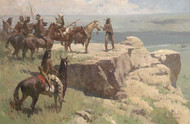Buckskin Leather Care
Posted by Leather Milk Customer Orders on Aug 23rd 2016
To be a pioneer is all about embracing change. As you leave civilization behind you, you can only carry so much. What is dispensable must be left behind, or it may get you killed. This does not mean that a pioneer is doomed to loneliness. Rather, the great pioneer understands that they are not only leaving their old neighbors behind them - they are exchanging them for new neighbors. The cotton fields back home, used to make the clothing we wear on our backs, are exchanged for the hunt, as wandering beasts take cotton's place on our backs. So it was for the pioneers of old - both Native Americans and European colonials, who found stability in the heart of an ever-changing, perilous frontier, as if they had wandered into the eye of a tornado. They adapted; they valued simple things as they had never valued them before, and became the agents of change in their own lives.
In short, they figured out they really, really liked buckskin leather. And why wouldn't they? Buckskin leather's gotta be one of the most timeless, recognizable materials in the biz. It's stylish, and got oodles of practical value as well. So it's no wonder it's still alive and kicking today, long after the days of the Great American Frontier have come and gone (we miss you!).
So what is buckskin leather? In short, buckskin is animal hide, prepared naturally, using a few different types of hides. The most common hides used to make buckskin were deer, buffalo, and elk. Way back when, these material were nearly ubiquitous. Sadly, they are not so much anymore.
Buckskin is a family of leather types known for their soft, pliable, and porous qualities. There are various synthetic varieties of this leather on the market today, usually made with sheepskin prepared from chromate tanning chemicals; these chrome-tanned leathers are afterwards dyed to imitate real buckskin. While this leather holds its own merits, it's not what we're really going to talk about today. Instead, natural buckskin is prepared using more natural, ancient techniques passed down through time.
How it's Made
You're all experts on leather tanning methods, right? It's pretty basic stuff most people know.
Just messing with you. If you'd like to read more on the topic, you check out our blog on Leather Tanning Methods here. In the meantime, I'll give you a Reader's Digest version on how buckskin leather is tanned and prepared.
Leather starts out pretty icky. It's got slimy flesh, blood, hair, and all sorts of stuff hanging all over it. To get all those things out, the leather undergos a variety of treatment steps, including scraping (where flesh and hair are removed from the animal's hide, either while it's wet or dry), dressing (preserving the hide from decay, using materials like egg yolks, an oil/soap/water solution, or even the animal's brains), and stretching (where the leather is stretched thin to ensure that the preservating dressing reaches every fiber inside the leather).
The most distinctive way buckskin leather is prepared happens after the leather is stretched. About this time, the leather should feel soft, supple, and dry. It's important that the leather possess these qualities, or else it could revert to a stiff, inflexible material. When the leather is ready, it is positioned to be saturated for an extended period of time in burning smoke, while great care is taken to prevent the leather from actually catching on fire (which is pretty easy). The smoke is usually funneled into an enclosed space containing the buckskin, to ensure maximum penetration through the leather. During this process, the buckskin leather changes from a plain, white color, to the familiar honey-brownish hue we know and love. Beyond aesthetic appeal, smoking also helps the buckskin deter insects, avoid becoming stiff when wetted, and makes it easier to wash. When the entire buckskin adopts this rich, honeyed hue, your newfangled leather is ready: buckskin leather is born.
How it's Maintained
Maintaining buckskin leather is fortunately a little bit easier than making it from scratch. To keep the leather preserved, it needs both protection from the elements and refreshing oils to stay supple and soft. That's where Leather Milk comes in (us!). Leather Milk carries a variety of leather care products, from cleaners to conditioners, designed to beautify and maintain your leather's health. Buckskin, while very durable, also needs a little TLC from time to time to get the most out of its lifespan. Due to buckskin's usually delicate, porous nature, it is wise to treat it with lighter leather conditioners, such as Leather Care Liniment. You can read more about this formula here. Because buckskin has a natural tendency to look after itself, you probably won't need to give it much attention. A light conditioning 3-4 times a year should more than suffice, depending upon the amount of use it gets and its exposure to the elements. It's best to use your best judgment. If the leather looks parched, condition it. If your leather looks dirty, clean it. Simple as that. Get to know your leather through experience. If you treat it well, it will treat you better.
Good ole Nostalgia
That's the basics on buckskin leather. It's a bold material, elegant and beautiful, and easy to maintain. In short, some of the best kind of leather you can ask for - and it shows. Buckskin leather is thriving today. The frontier days have been left far behind us, but our romantic minds have prevailed over time itself, treasuring the same kinds of things our ancestors treasured long before us. In this magic-like material, perhaps you could even say we have connection to them. If nothing else, it looks pretty snazzy.
Cheers, my leather aficionados!

